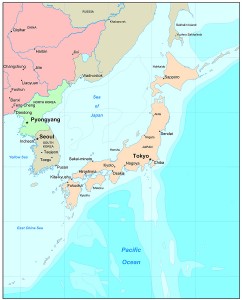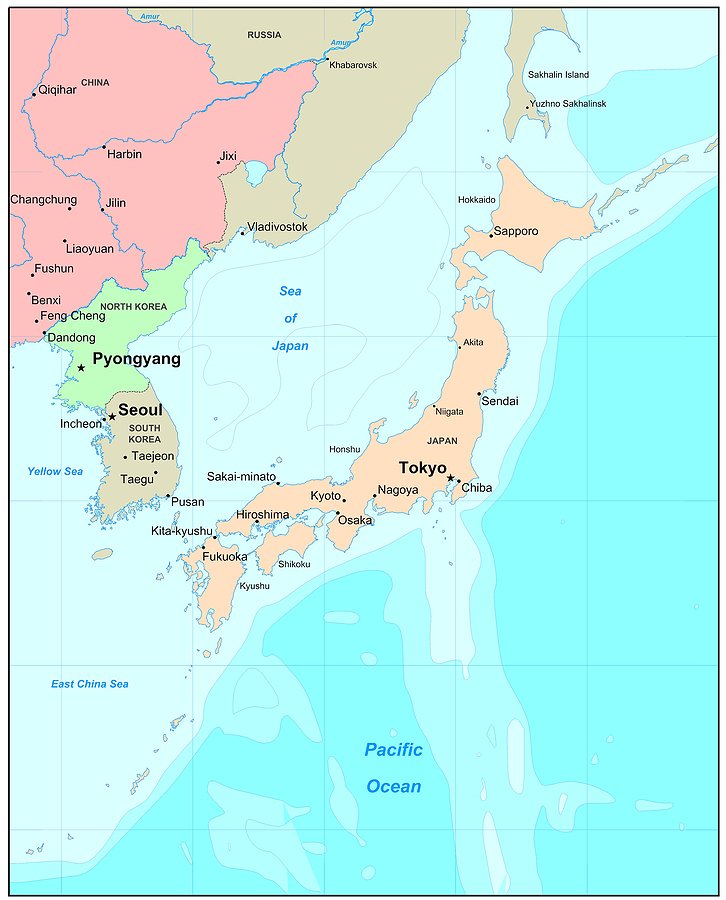2012-09-11 By Richard Weitz
Unlike in Europe, where the fall of the Berlin Wall and the collapse of the Warsaw Pact ushered as a new era, the Asia Pacific region did not experience an abrupt phase transition during the late 1980s and 1990s.
From Japan’s perspective, the demise of the Soviet Union was a mixed blessing in that it allowed China to reorient its military power from its northern and western direction toward its south and east. In addition, the demise of the Soviet threat against Japan was soon replaced by heightened concerns about North Korea’s expanding missile and nuclear capacity.
Japan also experienced one of the most serious incidents of domestic terrorism when an indigenous cult released Sarin gas in the Tokyo subway. Although Japan’s ties with Australia and India have improved, its relations with Russia and South Korea remain problematic.
For over a decade, Japanese security managers have had to consider a potential nuclear attack from the Democratic People’s Republic of Korea (DPRK).

In 1994, the U.S. intelligence community concluded that North Korea possessed a secret nuclear weapons program. The issue became less pressing after U.S. threats, South Korean inducements, and Japanese financial assistance convinced Pyongyang to suspend its program under the October 1994 Agreed Framework.
The launch of a DPRK long-range Taepodong-1 ballistic missile over Japanese territory in August 1998, however, produced a Sputnik-like shock effect. Japanese people and policy makers alike were now forced to consider the devastation that even a single North Korean missile, if armed with a nuclear warhead, could inflict on their country.
In response to the flight, the Diet unanimously passed a resolution of protest, and the Japanese government suspended both the talks on normalizing relations between the two countries and its food shipments to North Korea. Besides the still experimental Taepo Dong, North Korea also possesses hundreds of shorter-range Nodong missiles that could reach Tokyo and other Japanese cities. The government of Pyongyang has warned Japan that it lies “within the striking range of” North Korea and therefore should behave well.
The Japanese government launched its last genuine bilateral engagement initiative toward Pyongyang in the early 2000s. Its apogee occurred in September 2002, when Japanese Prime Minister Junichiro Koizumi visited North Korea. For example, the so-called Pyongyang Declaration, which was signed during Koizumi’s visit, still establishes the requirements for a genuine Japanese-DPRK reconciliation.
However, the gesture backfired when DPRK leader Kim Jong-il admitted to Koizumi that Pyongyang had kidnapped more than a dozen Japanese between 1977 and 1983 to serve as language instructors for the DPRK intelligence community.
Although North Koreans attributed the seizures to overzealous secret agents, the acknowledgement, which followed years of DPRK denials, enraged the Japanese public, who demanded more information about the issue than the secretive North Korean leadership proved willing to provide. Kim claimed that eight of the acknowledged abductees had died, but the still secretive North Korean government proved unable to provide an outraged Japanese government and public opinion sufficient information to prove this claim.
After DPRK authorities handed over the ashes of one of the dead abductees, DNA tests showed that they belonged to someone else. Many Japanese remain unconvinced that most of the abductees died in North Korea and suspect that the number seized was actually higher. Family members of the abductees as well as Japanese human rights groups have collaborated with sympathetic government officials to keep the issue prominently in the Japanese media.
When the DPRK permitted the five children born to former abductees to visit Japan in October 2002, the Koizumi government refused to compel their return. DPRK representatives subsequently refused to reopen the issue and called on Tokyo to pay reparations North Korea for Japan’s colonial occupation, restore full diplomatic relations with Pyongyang, and remove its sanctions on DPRK commercial activities.
Since the abduction issue arose in 2002, it has impeded substantial progress in the bilateral negotiations aimed at establishing diplomatic relations and resolving mutual disagreements between Japan and North Korea.
Despite Japanese threats and pleas, North Korea resumed test launching ballistic missiles over the Pacific Ocean in July 2006, ending the moratorium the DPRK had maintained regarding such tests since September 1999.
North Korea’s subsequent test of a nuclear explosive in October 2006 constituted the first technological step toward developing a nuclear warhead sufficiently small for delivery aboard a ballistic missile.
In response, the Japanese government progressively expanded its range of sanctions on North Korea and strongly supported punitive UN Security Council resolutions that condemned the actions and called for trade restrictions.
In addition, Japan adopted a “dialogue and pressure” approach by imposing unilateral sanctions that were more stringent than found in UNSC resolutions, including a ban on all North Korean ships in Japanese ports, restrictions on imports and on most North Koreans entering Japan, and a freeze on bank remittances to North Korea from the ethnic Korean community in Japan.
In April 2007, Yuriko Koike, the first person appointed to the new post of national security adviser, called North Korea an “enormous” threat to Japan. Koike explained that Tokyo would insist that the DPRK take concrete action to end its nuclear program because its “missiles, with a nuclear warhead maybe, may reach the territory of Japan in about seven or eight minutes.”
Even when some progress has occurred in the Six Party Talks seeking to secure the denuclearization of the Korean Peninsula, the Japanese government has adopted a much firmer stance than that the United States, South Korea, China, or Russia. Notwithstanding the February 2007 Six-Party agreement, Japanese leaders have expressed widespread skepticism that the DPRK will ever eliminate its nuclear weapons program.
Japanese officials regularly lobby their U.S. counterparts no to make major concessions to the DPRK until North Korea clarifies the status of the abducted Japanese.
For example, Tokyo and Washington required lengthy bilateral negotiations to resolve their differences over whether to remove the DPRK from the U.S. list of state sponsors of terrorism. U.S. authorities added Pyongyang to the list after government investigators concluded that North Korean agents were responsible for the 1987 bombing of a South Korean civilian airliner, which killed all 115 people on board.
DPRK negotiators have long demanded the removal because their designation requires the United States to veto proposed International Monetary Fund and World Bank assistance to the DPRK. It also excludes U.S. arms sales to North Korea and constrains unilateral economic aid.
More recently, Japanese legislatures have pressed the United States not to provide substantial food aid to the DPRK until the abductee issue is solved.
Furthermore, Japanese leaders have expressed widespread skepticism that the DPRK will ever relinquish its nuclear weapons program even if all the parties remove the abductees issue from the negotiating table.
Even if North Korea were to eliminate its nuclear arsenal to satisfy the United States, the DPRK would still possesses hundreds of shorter-range Nodong-1 missiles that could attack Japan’s main cities with conventional warheads.
Japanese intelligence concluded from the July 2006 Nodong launches that the DPRK had developed the capacity to employ these mobile missiles with high accuracy against potential targets in Japan.
Japanese officials complain to their U.S. counterparts that the United States and the other parties to the Six-Party Talks do not pay sufficient attention to the DPRK’s missile capabilities.
Thus far, the DPRKs hardline negotiating stance, its provocations against all three governments, and its generally belligerent policies have helped paper over potential divisions between Washington, Tokyo, and Seoul.
Nonetheless, we cannot forever count on inept DPRK diplomacy to bind the three countries together.
For a look at the dynamic defense approach, please look at our piece on the latest Japanese defense white paper.


